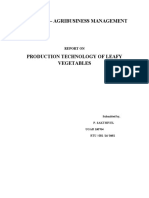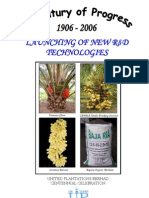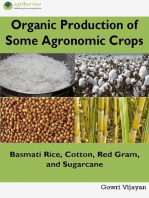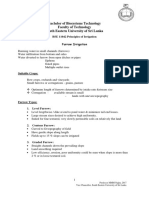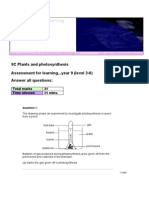Cabbage Simplified Guide by Dahlia
Cabbage Simplified Guide by Dahlia
Uploaded by
dahlia nyangaCopyright:
Available Formats
Cabbage Simplified Guide by Dahlia
Cabbage Simplified Guide by Dahlia
Uploaded by
dahlia nyangaCopyright
Available Formats
Share this document
Did you find this document useful?
Is this content inappropriate?
Copyright:
Available Formats
Cabbage Simplified Guide by Dahlia
Cabbage Simplified Guide by Dahlia
Uploaded by
dahlia nyangaCopyright:
Available Formats
CABBAGE PRODUCTION
A Simplified Guide
YOUR PARTNER IN CHEMICAL SUPPLIES
By Dahlia Shumba 0775589553
Cabbage Production
Crop Cabbage
Classification Family Cruciferaceae
Genus Brassica
Species oleracea
Sub-species Capitate
Nursery management
Seed requirement Seeds/gram 200-350
Seeds/m² 1000seeds (4g) same for all heading vegetables
Seeds/ha Seed trays – 150-250g
Conventional seedbed – 250-300g
Insitu- not recommended because it’s not economic
Periodical time to Planting All year round- variety performance differ with seasons
Emergence 5-7days, depending on conditions prevailing
Transplanting 35days from planting, 28days from emergence
Soil temperature for Minimum 4⁰C, Low temperatures lead to poor or slow germination
germination Optimum 18-35⁰C, Optimum temperature = Good germination
Spacing Sowing depth 1cm Maintain depth for good emergence
Inrow spacing 0.5-1cm Avoid overcrowding your seedlings as this may
Interrow spacing 5-7cm lead to week seedlings
Conventional bed Manure/m² 10kg Broadcasted evenly and incorporated with the soil
preparation Compound C/m² 45g
requirements
AN/m² 35g Broadcasted 2 weeks after emergence
Managenent Bed preparation Dig a bed 1m wide with a length enough to accommodate your seeds
Broadcast well decomposed manure and Compound C, then
incorporate lightly into the soil
Drill lines 1cm deep, 10cm apart and sprinkle the seeds (4g/m²) trying
to achieve 1cm between seeds
Cover the seeds lightly with manure or any other light materials like
sand
Erect a shed 10-20cm from the ground then remove soon after
emergence
Watering Maintain the moisture at optimum, avoid overwatering or
underwatering
Top dressing Broadcast at week 2 after emergence and follow up with light
irrigation. Wingrow can also be used if the seedlings are too stunted
Spraying Spray Acetamiprid + Abamectin and Copper/Mancozeb every week to
make sure the seedlings are healthy
Hardening Around 4 weeks from emergence, the seedlings will be ready for
transplanting, harden them by withdrawing water for about 2-3 days
until they start showing wilting signs by 10am, so that they easily
adopt to the field conditions
Field Management
Crop Cabbage
Soil requirements Soils Clay loams rich in Organic manure
Your Partner in chemical supplies
pH 5.5-6.5
Climatic Temperature 18-30
requirements Water requirement Heavy
Ease of care Difficult
Spacing Interrow 60-90cm
Inrow 30-60cm
Plant population Minimum 20k
Maximum 45k
Varieties Early maturity 65-80days Fabiola, Kilimo, Athena plus
Medium 85-110days 3301, 3311, 3317, Indica, Gemma, Copenhagen market, Corton,
Marcanta, Delight
Late 110-150days Drumhead, 3316
Fertilisation
Application Fertiliser Composition Rate N P K Remarks
g/plant
Basal Compound C 5:15:12 30 1.8 4.5 3.6 Notes 1
Top dressing Ammonium Nitrate 34.5%N 15 5.2 Notes 2
7 4.5 3.6
Foliar spray Wuxal macromix 16 : 16 : 12 2ltr At week 3, 5 and 7 (Notes 3)
Wuxal calcibor 9%N, 14%Ca 2ltr At week 4 and 5 (Notes 4)
1. Compound C at 30g/plant before planting, avoid direct contact of the roots and fertiliser
2. Ammonium nitrate, apply 5g/plant at week 1, 2 & 3 (summer), 2, 4 & 6 (winter) after transplanting
3. Wuxal macromix- foliar spray at 16ml/16l every 2 weeks at week 3, 5 and 7
4. Wuxal calcibor- foliar spray at 16ml/16l every 2 weeks at week 4 and 5
*Total fertiliser application = Rate/plant * Plant population (Divide by 1000 to convert to kgs)
Herbicides
Pre-emergence Metolachlor
Post-emergence Propaquizafop, Fluazifop-p-Butyl
Insects
Aphids (Brevicoryne Bagrada bug (Bagrada Whitefly (Bemisi tabaci) Thrips (Thrips tabaci)
brassicae) hilaris)
Your Partner in chemical supplies
Methomyl, Imidacloprid, Acetamiprid, Malathion, Dichlorvos Deltamethrin, Chess, Thiamethoxam
DBM (Plutella xylostella) Webworm (Hellula undalis) Semi-looper (Trichoplusia ni)
B. thrungiensis, Acephate, Cartap hydrochloride, Deltamethrin, Emamectin benzoate, Lufenuron, Indoxacarb,
Fipronil, Flubendiamide, Chlorantraniliprole, Mercaptothion, Abamectin, Malathion, Dichlorvos, Methomyl,
Diazinon, Chlorpyrifos
Redspider (Tetranychus urticae) Cabbage root fly (Delia radicum) Cutworms (Agrotis ipsilon)
Amitraz, Dicofol, Abamectin, Abamectin, Imidacloprid, Chlorpyrifos, Lambda cyhalothrin,
Diazinon, Profenofos Acetamiprid, Malathion, Carbaryl, Deltamethrin
Dichlorvos, Deltamethrin,
Flubendiamide, Acephate, Cartap
hydrochloride
Fungal diseases
Damping off (Pythium spp) Downey mildew (Peronospora White rust (Albugo candida)
parasitica)
Mancozeb, Copper oxychloride,
Captan, Copper oxychloride, Mancozeb, Copper oxychloride,
Chemlaxyl, Chlorothalonil
Mancozeb, Thiram, Chemlaxyl Chemlaxyl, Chlorothalonil, Antracol
Your Partner in chemical supplies
Ring spot (Mycosphaerella Black leafspot Powdery mildew (Erysiphe Leaf blight (Phytophtora
brassicicola) (Alternaria brassicicola) cruciferarum) brassicicola)
Mancozeb. Chemlaxyl, Mancozeb, Copper Mancozeb, Copper Mancozeb, Copper
Antracol, Chlorothalonil, oxychloride, oxychloride, Tebuconazole, oxychloride, Chemlaxyl,
Copper oxychloride Tebuconazole, Chlorothalonil, Chlorothalonil, Antracol
Chlorothalonil, Difenoconazole
Difenoconazole
Bacterial Diseases
Black rot (Xanthomonas campestris) Bacterial wilt (Pseudomonas Soft rot (Erwinia carotovora)
syringae)
For all bacterial diseases
✓ Avoid excessive use of nitrogen
✓ Keep crops free from pests and diseases
✓ Hybrids have better bacterial disease tolerant
✓ Plant certified seed
✓ Use Acibenzolar-S-methyl
✓ Harvest onions during dry conditions
Viral Diseases
Turnip yellow virus Keep crop free from sap sucking pests (Aphids, Thrips etc)
Plant resistant varieties especial hybrids
Turnip mosaic virus
**Always read the labels on chemicals for rates and post-harvest intervals
**Chemicals listed in active ingredients, trade names may differ
**Chemical colour codes do not illustrate the effectiveness in pest control, but the toxicity to the operator
Your Partner in chemical supplies
Cabbage Program
Plant pop Area Spacing Variety
Week after Foliar sprays/ Herbicides/16l
transplanting Age Date Fertilisers/ plant Pesticides/16l Fungicides/16l 16l
Transplanting Compound C 30g Lambda16ml Metolachlor 120ml
1 7 Dichlorvos 16ml Copper 80g
2 14 AN 5g Demise 16ml Bravo 32ml
3 21 AN 5g Savage 8ml Mancozeb 50g Macromix 80ml
4 28 Carbaryl 50g Bion 5g Calcibor 80ml Fluazifop 80ml
5 35 AN 5g Dichlorvos 16ml Copper 80g Macromix 80ml
6 42 Demise 16ml Bravo 32ml Calcibor 80ml
7 49 Savage 8ml Mancozeb 50g Macromix 80ml
8 56 Carbaryl 50g Copper 80g
9 63 Dichlorvos 16ml Bravo 32ml
10 70 Demise 16ml Mancozeb 50g
11 77
12 84
Your Partner in chemical supplies
You might also like
- Potato Production ZimDocument7 pagesPotato Production ZimStanley OtienoNo ratings yet
- Nursery Management in CoffeeDocument2 pagesNursery Management in CoffeeDelfin Acay50% (2)
- Farm Management Handbook (Crops)Document146 pagesFarm Management Handbook (Crops)obertNo ratings yet
- Tress SoongDocument2 pagesTress SoongLG Niegas50% (2)
- Awami National Party Manifesto 2008 (English)Document7 pagesAwami National Party Manifesto 2008 (English)Awami National Party100% (1)
- Carrot Complete GuideDocument5 pagesCarrot Complete GuideBenjamin TondondoNo ratings yet
- Wheat Complete Guide. - 012334Document4 pagesWheat Complete Guide. - 012334joeshoniwa2100% (1)
- 04 Soya BeanDocument7 pages04 Soya BeanNk MeenaNo ratings yet
- Carrot Simplified GuideDocument5 pagesCarrot Simplified Guidedahlia nyangaNo ratings yet
- Potato Complete Guide.Document6 pagesPotato Complete Guide.onward marumuraNo ratings yet
- Cucumber: Crop GuideDocument4 pagesCucumber: Crop GuideGerald MagingaNo ratings yet
- Philippines-Factsheet Kangkong Field English PDFDocument3 pagesPhilippines-Factsheet Kangkong Field English PDFeychezdy07No ratings yet
- Brussels Sprouts TN 2020Document5 pagesBrussels Sprouts TN 2020Fursey WhyteNo ratings yet
- Maize Seed ProductionDocument9 pagesMaize Seed ProductionrioabineshvjNo ratings yet
- FIELD GUIDE IN SITAO PRODUCTION Revised NovDocument3 pagesFIELD GUIDE IN SITAO PRODUCTION Revised Novrtrada23No ratings yet
- Tomato Complete Guide.Document7 pagesTomato Complete Guide.Benjamin TondondoNo ratings yet
- Baby Marrow Complete Guide (1) - 012346Document7 pagesBaby Marrow Complete Guide (1) - 012346joeshoniwa2No ratings yet
- Tomato Complete Guide.-1Document8 pagesTomato Complete Guide.-1apostlecmutandidzigwaNo ratings yet
- Tomato Simplified GuideDocument6 pagesTomato Simplified Guidedahlia nyangaNo ratings yet
- Abm - Hot - Agribusiness Management: Report OnDocument6 pagesAbm - Hot - Agribusiness Management: Report Onyazhini thangaveluNo ratings yet
- Century of Progress 161008Document20 pagesCentury of Progress 161008Cheong Ying ZhiNo ratings yet
- Forage Description 1Document24 pagesForage Description 1Roy ResurreccionNo ratings yet
- GerberaDocument17 pagesGerberakashyapatel5998No ratings yet
- SPIC TC Banana CultivationDocument6 pagesSPIC TC Banana CultivationBala SubramaniamNo ratings yet
- Butternut Production GuideDocument5 pagesButternut Production Guidedaddy.wafaNo ratings yet
- Okra Production Guide - Beta - 356244Document2 pagesOkra Production Guide - Beta - 356244Kristine Joy PoliquitNo ratings yet
- ButternutDocument6 pagesButternutmendymphonyana02No ratings yet
- Potato Production: Variety SelectionDocument3 pagesPotato Production: Variety SelectionEthy Wa WaleNo ratings yet
- Maguires Tobacco Growers GuideDocument25 pagesMaguires Tobacco Growers GuideMsalimNo ratings yet
- Cucumber: Crop GuideDocument4 pagesCucumber: Crop GuideDidi CarsidiNo ratings yet
- Cabbage GrowingDocument9 pagesCabbage GrowingEthy Wa WaleNo ratings yet
- Carnation Cultivation PDFDocument13 pagesCarnation Cultivation PDFamar100% (2)
- Potato Production PresentationDocument7 pagesPotato Production Presentationsaunyamatashinga32No ratings yet
- Potato Simplified GuideDocument8 pagesPotato Simplified Guidedahlia nyangaNo ratings yet
- Rice Seed ProductionDocument8 pagesRice Seed ProductionrioabineshvjNo ratings yet
- How To Grow Field CornDocument4 pagesHow To Grow Field CornAllanaNo ratings yet
- L06. Hort181 - Banana - BasicsDocument5 pagesL06. Hort181 - Banana - BasicsAmit GoenkaNo ratings yet
- Banana: Musa Acuminata)Document34 pagesBanana: Musa Acuminata)M ImranNo ratings yet
- Pepper Brief GuideDocument2 pagesPepper Brief GuideTatenda LwandaNo ratings yet
- Equator CatalogueDocument25 pagesEquator CatalogueNorman Adimo100% (1)
- Redgram Seed ProductionDocument6 pagesRedgram Seed ProductionrioabineshvjNo ratings yet
- Tof Magazine January 2021 IssueDocument8 pagesTof Magazine January 2021 Issuemohamed adamNo ratings yet
- Avocado Production CultivationDocument2 pagesAvocado Production CultivationBernard Kipng'eno100% (1)
- Tips For Soyabean Cultivation: Time of SowingDocument2 pagesTips For Soyabean Cultivation: Time of SowingBHAGYASHRINo ratings yet
- Package of Practices For Rice (Bargarh District) : S.NO. Cropping Situation Suitable VarietiesDocument6 pagesPackage of Practices For Rice (Bargarh District) : S.NO. Cropping Situation Suitable Varietiesjaspal singhNo ratings yet
- Matag Coconut 1. Matag CoconutDocument4 pagesMatag Coconut 1. Matag CoconutNek YakkNo ratings yet
- Lalbabu (ELP) HORTIDocument16 pagesLalbabu (ELP) HORTIMIT RAVNo ratings yet
- Granadilla Production KenyaDocument72 pagesGranadilla Production Kenyatinyiko100% (1)
- Training Manual-G-nutsDocument15 pagesTraining Manual-G-nutsopiro stephenNo ratings yet
- PEASDocument9 pagesPEASripichjamieNo ratings yet
- Seed Treatment - Methods, Objectives and Pre-Storage TreatmentDocument5 pagesSeed Treatment - Methods, Objectives and Pre-Storage Treatmentmamadou bailo bahNo ratings yet
- Produce Organic VegetablesDocument90 pagesProduce Organic VegetablesAdelina Idanan100% (2)
- P A C P V: EA EA ArietiesDocument4 pagesP A C P V: EA EA ArietiescarlosisazaNo ratings yet
- Guayabano Production GuideDocument7 pagesGuayabano Production GuideJobert ArcillaNo ratings yet
- Assignment On: Cultivation Practices of BajraDocument26 pagesAssignment On: Cultivation Practices of BajraAbhishek kumarNo ratings yet
- Annabelle C en South EuropeDocument2 pagesAnnabelle C en South EuropeTio LuNo ratings yet
- IPM Schedule For Chilli Cultivation: Ralstonia, Alternaria EtcDocument4 pagesIPM Schedule For Chilli Cultivation: Ralstonia, Alternaria EtcHonnur BashaNo ratings yet
- CucumberDocument6 pagesCucumberMd Sahin SirajNo ratings yet
- Always Read Labels Before Using The ProductsDocument1 pageAlways Read Labels Before Using The ProductsShadreck MabvoroNo ratings yet
- Production Guidelines For Rice: © FAO / Shahida Sarker ParulDocument7 pagesProduction Guidelines For Rice: © FAO / Shahida Sarker ParulNitin ShingoleNo ratings yet
- Organic Production of Some Agronomic Crops: Basmati Rice, Cotton, Red Gram and SugarcaneFrom EverandOrganic Production of Some Agronomic Crops: Basmati Rice, Cotton, Red Gram and SugarcaneNo ratings yet
- Methods and Techniques of IrrigationDocument9 pagesMethods and Techniques of IrrigationEmmanuel Sto TomasNo ratings yet
- Cole Et Al. - 2008 - Healthy City Harvests Generating Evidence to GuidDocument285 pagesCole Et Al. - 2008 - Healthy City Harvests Generating Evidence to GuidClay MillerNo ratings yet
- All Career ClustersDocument50 pagesAll Career ClustersfunandfearlessNo ratings yet
- Book of Abstracts PDFDocument203 pagesBook of Abstracts PDFionescu_ion_3No ratings yet
- Design and Fabrication of Multipurpose Agricultural MachineDocument7 pagesDesign and Fabrication of Multipurpose Agricultural MachineIJRASETPublicationsNo ratings yet
- RRLsDocument17 pagesRRLsAgnes FernandezNo ratings yet
- Comparing Environmental Impacts For Livestock Products PDFDocument11 pagesComparing Environmental Impacts For Livestock Products PDFDante Fernández BacaNo ratings yet
- SCR - Report Mohammed Kaif AhmedDocument37 pagesSCR - Report Mohammed Kaif Ahmedrajmouli517No ratings yet
- Monopoly Real Life Examples: Example 1Document7 pagesMonopoly Real Life Examples: Example 1Rafia MalikNo ratings yet
- Trend Detection of Rainfall in Alluvial Gangetic Plain of UttarakhandDocument7 pagesTrend Detection of Rainfall in Alluvial Gangetic Plain of UttarakhandharshitNo ratings yet
- Building A New Path To Dryland No-Till Prosperity: by John Dobberstein, Managing EditorDocument10 pagesBuilding A New Path To Dryland No-Till Prosperity: by John Dobberstein, Managing EditorAnonymous 1XBCMXNo ratings yet
- State: Jharkhand Agriculture Contingency Plan For District: BokaroDocument35 pagesState: Jharkhand Agriculture Contingency Plan For District: BokarosunilkumarchaudharyNo ratings yet
- Furrow IrrigationDocument8 pagesFurrow Irrigationkajako kajoNo ratings yet
- Amrita Mukherjee 2022Document170 pagesAmrita Mukherjee 2022Dinko BećirspahićNo ratings yet
- 9C QPDocument9 pages9C QPPoornimaNo ratings yet
- RAWE-476 Agricultural Economics: ContentDocument7 pagesRAWE-476 Agricultural Economics: ContentSanket BangarNo ratings yet
- PAPUANEWDocument94 pagesPAPUANEWPhil HomsNo ratings yet
- Social Class 10 2019Document14 pagesSocial Class 10 2019krishnareddy_chintalaNo ratings yet
- Gender Role in Agricultural Activities in Ethiopia: Country ReviewDocument7 pagesGender Role in Agricultural Activities in Ethiopia: Country ReviewTemesgen M. MandersoNo ratings yet
- Maritime CurriculumDocument48 pagesMaritime CurriculumDukiekoy PenasoNo ratings yet
- Pizza Industry AnalysisDocument14 pagesPizza Industry AnalysisAbriel BumatayNo ratings yet
- By513536 (4659)Document11 pagesBy513536 (4659)Shah ZamanNo ratings yet
- Land Tenure System in NigeriaDocument7 pagesLand Tenure System in Nigeriaejikemefavour26No ratings yet
- Leaves: Lower Epidermis Upper Epidermis Palisade LayerDocument9 pagesLeaves: Lower Epidermis Upper Epidermis Palisade LayerAndrea ValiaoNo ratings yet
- 1 Objective of The StudyDocument19 pages1 Objective of The StudyMahesh DharapNo ratings yet
- Grade 7 Targeter Wings 002 KiswahiliDocument4 pagesGrade 7 Targeter Wings 002 KiswahiliJenipher AchokiNo ratings yet
- Registered Horticultural Exporters 2020Document1 pageRegistered Horticultural Exporters 2020ZachariahNo ratings yet
- Project Proposal FOR: General Plastic (Document58 pagesProject Proposal FOR: General Plastic (Tesfaye Degefa100% (3)



















